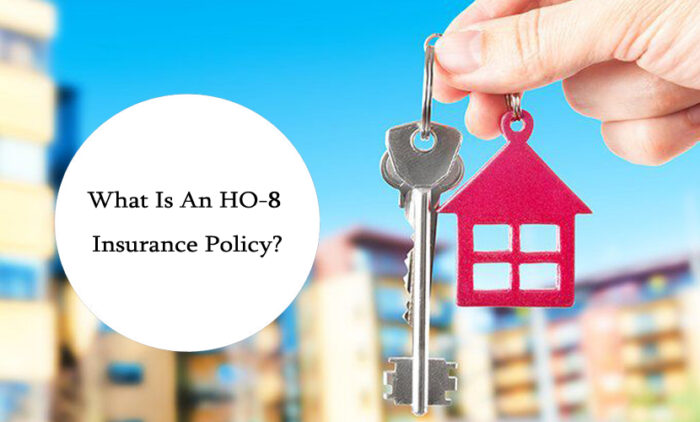What is an HO-8 insurance policy? This is an insurance policy that addresses the needs of homes that are not eligible for conventional insurance policies because of their historical value, age, or construction materials.

Furthermore, an HO-8 insurance policy is created by factors like repair and the cost of rebuilding. But what is an HO-8 insurance policy all about, and how does it work? Well, you are about to find out.
What Is An HO-8 Insurance Policy?
An HO-8 insurance policy is also known as a modified coverage form of homeowners insurance. It is designed for older homes, specifically where the total cost of rebuilding exceeds the market value.
This type of policy is very beneficial for homes or houses that have architectural structures or are registered as historic properties.
Thus, a standard homeowners insurance quote is not very practicable because of the high and expensive cost of restoration with the original craftsmanship and materials.
How Does It Work?
This type of insurance works or operates by offering coverage that considers the special areas of older and historically significant homes or houses.
Unlike standard homeowner policies, for instance, HO-3, where you receive replacement cost coverage, the HO-8 insurance policy provides cash value coverage.
This implies that you will get coverage for the cost of replacement and repair of the damages to the property, minus depreciation.
To summarize, an HO-8 insurance policy works to make sure that these historically or architecturally significant homes are repaired.
What Does An HO-8 Insurance Policy Cover?
An HO-8 insurance policy offers the same type of coverage offered by a standard homeowners insurance quote. However, one of the major differences is that HO-8 covers only your personal belongings and homes. Here are the coverages that complete an HO-8 insurance quote:
- Personal property coverage.
- Dwelling coverage.
- Other structures coverage.
- Medical payments coverage.
- Loss of use coverage.
- Personal liability coverage.
Here are the covered perils of the same policy:
- Explosions.
- Fire or lightning.
- Volcanic eruptions.
- Civil commotion or riots.
- Theft.
- Windstorms.
- Hail.
- Aircraft damage.
- Smoke.
- Vehicle damage.
- Vandalism or malicious mischief.
Hence, if these perils are covered by your policy, your insurance company or provider will offer the necessary coverage and compensation for the damage.
What Does It Not Cover?
While HO-8 covers a lot of accidents and perils, there are certain things it doesn’t cover. They include:
- Mold or pest infestations.
- Wear and tear.
- Power failure.
- Intentional loss.
- Water damage.
- Government actions.
- Building code enforcement.
- Falling objects.
- Winter weather damage.
However, keep in mind that some of the risks mentioned above can be covered by specific additional quotes.
How Much Does The HO-8 Insurance Policy Cost?
According to the National Association of Insurance Commissioners, the average price for purchasing this policy is $2,035 per year.
However, note that this isn’t the fixed price, as you will come across various insurance providers with different prices and factors used to determine the premium cost.
Meanwhile, here are various factors that affect the cost of a policy. They include:
- Coverage limits.
- Historical significance.
- Condition of the property.
- Insurance provider.
- Credit score.
- Claim history.
- Policy options.
HO-8 policies are generally more expensive than standard homeowners insurance, but you can still gather quotes from potential insurers to find the best option.
Who Needs A Policy?
HO-8 is a specialized form of insurance for homes with out-of-date features and unique building materials. To find out if you need a policy, here are the categories you need to fall into:
- Protected homes or historical landmarks.
- Homes that are older than 40 or 50 years.
- Homes or houses built or constructed with rare and outdated materials.
How To Get An HO-8 Insurance Policy
Obtaining this policy is quite straightforward. The first thing you need to do is research insurance companies that offer such policies. Although it is a bit rare, there are still active providers you can find out there.
Next, prepare all the necessary information about your home and get in touch with the insurance company for a quote.
Give the documentation and information, review before agreeing with the terms of the policy, and lastly, make your first premium payment.
Frequently Asked Questions
What Is The Difference Between An HO-3 And An Ho-8 Insurance Policy?
The most significant distinction between HO-8 and HO-3 policies lies in their approach to covered perils: HO-8 policies operate on a named peril basis. In other words, they only cover risks explicitly listed in the policy.
On the other hand, HO-3 policies are open-peril policies, offering coverage for all perils except those specifically excluded in the policy documentation.
Consequently, HO-3 policyholders enjoy broader protection, whereas HO-8 policyholders are covered only for specified risks.
Given the higher risk associated with older homes, residents of such properties typically cannot secure HO-3 coverage.
What Does HO-8 Mean?
“HO-8” is the insurance industry’s term for the “Modified Coverage Form.” It specifically caters to older homes, historic residences, or those with architectural significance.
These properties often pose unique challenges for insurance coverage, particularly when the cost to rebuild using similar materials far exceeds the market value of the home.
Is HO-8 Actual Cash Value?
Yes, the HO-8 insurance policy provides coverage based on the actual cash value (ACV) of the home and its structures.
Therefore, if you experience a covered loss, your quote will pay out the cost to repair or replace the damaged parts of the home or lost personal property, minus depreciation.



